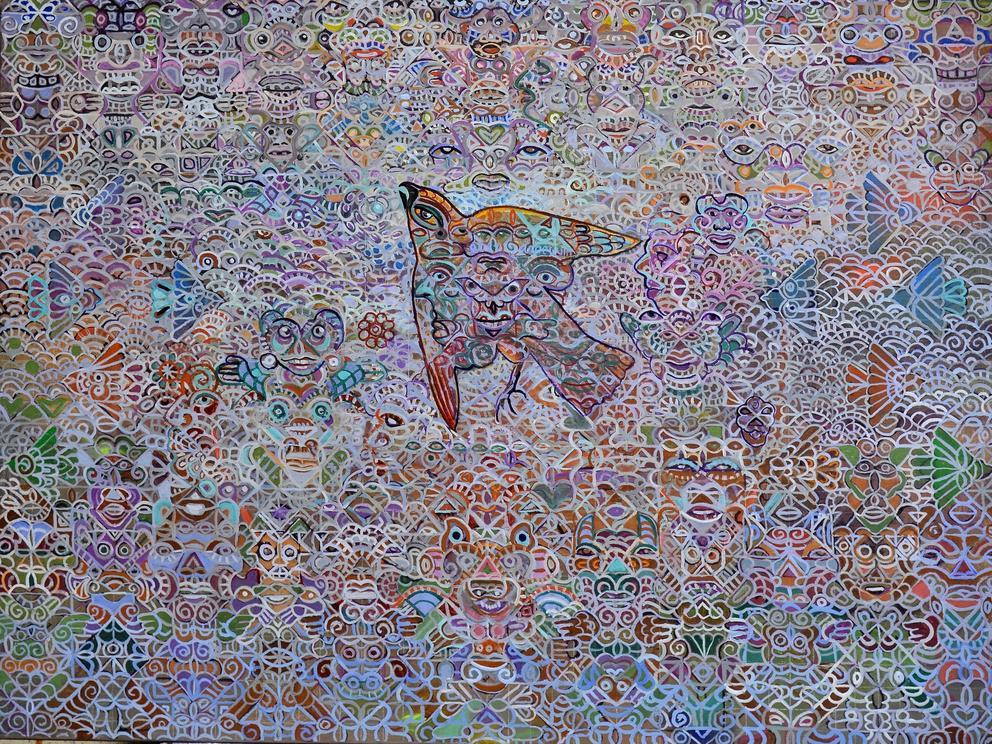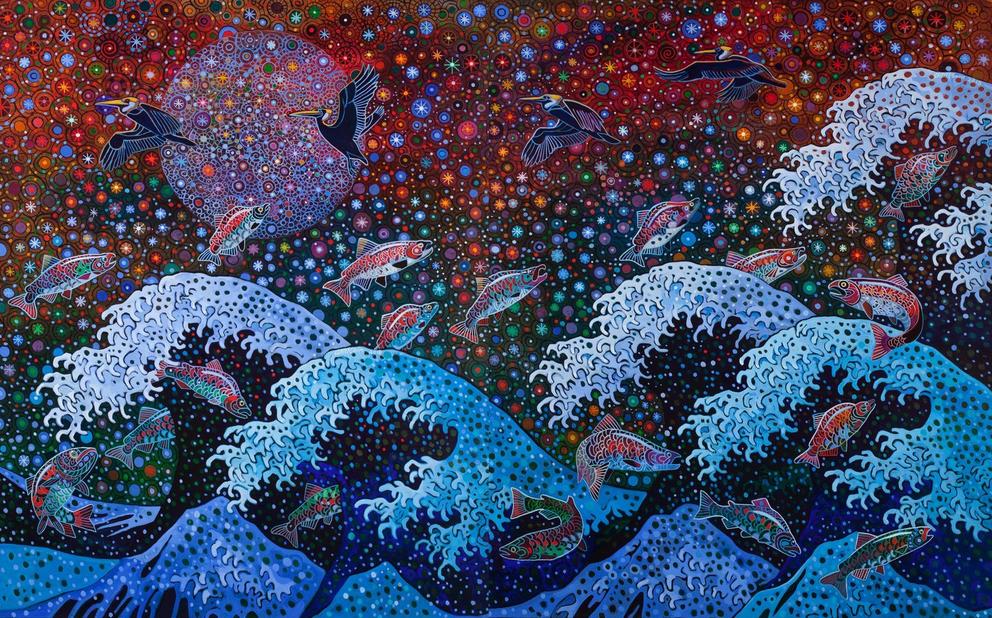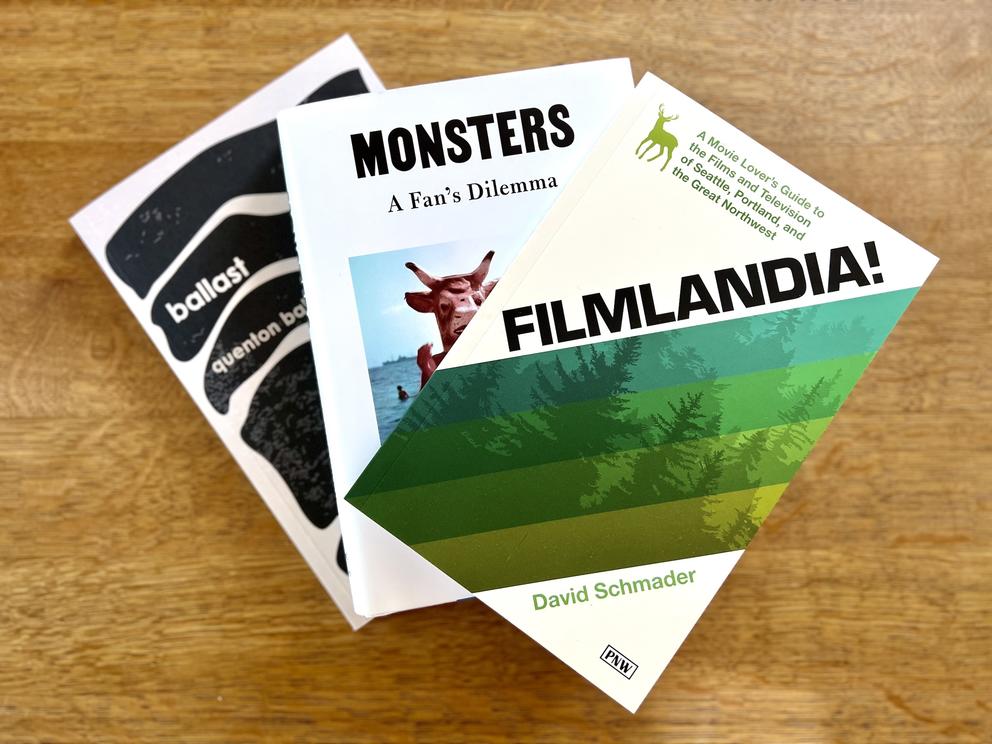Known for his “pattern paintings” — mosaic grids of vivid color in which faces and animals bubble up and shape-shift — Arreguín was also beloved for his generosity toward the Northwest Latino art community as well as his gregarious and encouraging personality. (The few times I encountered him at gallery events, I joined the ranks of the instantly charmed.)
ArtSEA: Notes on Northwest Culture is Crosscut’s weekly arts & culture newsletter.
Born in Morelia in the state of Michoacán, Mexico, Arreguín came to the Pacific Northwest in 1956 thanks to a chance meeting with a Seattle couple vacationing in Acapulco. Once settled in the U.S., he soon hit a detour: He was drafted to serve in Korea.
But after his tour of duty, Arreguín returned to Seattle and earned both a B.A. and MFA in fine art from the University of Washington. His work is now in the Smithsonian’s permanent collection: at the National Museum of American Art and the National Portrait Gallery.
I wrote about Arreguín’s work in July, when he was the subject of a terrific retrospective, Painter from the New World, at the Museum of Northwest Art in La Conner. At that time we had all just seen the first spectacular images of deep space from the James Webb telescope. They reminded me of Arreguin’s work — both seemed to reflect the mysteries of the universe.
You can point to direct influences in his paintings: Frida Kahlo, Aztec masks, jungle creatures, swimming salmon. But there is also something psychedelic, achieved through his meticulous layering of imagery.
As his friend the poet Tess Gallagher says of his work in a 2008 Seattle Channel profile of the artist, “You really see the universe, the cosmos in a different way. All the particles come together of color and oxygen and night and beings.”
Arreguín did seem tapped into a different way of experiencing the world. In a 2021 interview with KNKX, he is asked if there’s anything he still wants to do in his life. “I would love to learn how to fly,” he answers with a laugh. For a moment we are convinced he just might.
“When you get to my age,” Arreguín continues, “if you are flowing on the river to the sea, in a real comfortable boat, just enjoy the last days of your trip before you hit that other part, you know?”
This Saturday (April 29) is Seattle Independent Bookstore Day, and the weather is promising to be warm and sunny as you run around town basking in literature. The annual event’s “passport challenge” is back, encouraging you to visit as many of the 27 participating bookstores as possible (you get 10 days to do so).
Many participating bookstores will also have in-store events, such as cookbook author talks — including Seattle food star J. Kenji López-Alt — at Book Larder and a literary costume contest (catnip for word nerds!) at Arundel Books.
And just in time, there’s a whole slew of new books by Northwest authors for you to consider.
I just finished reading memoirist Claire Dederer’s excellent new nonfiction book, Monsters: A Fan’s Dilemma. In it she grapples with the longstanding question of whether we can still enjoy the beauty of art when it is made by people (usually men, usually called “geniuses”) who commit terrible acts.
Starting with Roman Polanski and Woody Allen and proceeding as a true essayist, Dederer probes deep and uncomfortable places both in consumer culture and within herself to try to extract an answer — and ends up glimpsing monsters hiding within all artists, and maybe even all of us. (Dederer’s next book tour event is a virtual conversation with author Meg Wolitzer, April 29 at 7:30 p.m.)
Great in an entirely different way is ballast, the new collection of poems by Seattle poet Quenton Baker. In case you missed it, Baker is the writer with whom Crosscut launched Black Arts Legacies: Season 2 earlier this week. Read Jas Keimig’s beautiful profile of Baker, and check the site for a new artist each week through June.
Based on an astonishing historic event, ballast is spare and powerful — including multiple pages of an 1800s U.S. Senate document detailing a successful mutiny on a slave ship. Baker has redacted the official record down to a sprinkling of words (e.g., “a cargo of alarm”) that elucidate the untold stories of the enslaved people on board. The effect is pulsing and resonant.
Also visually striking is Northwest photographer Matika Wilbur’s long-awaited new book, Project 562: Changing the Way We See Native America. It’s the culmination of Wilbur’s 10-year effort to travel the country and photograph members of each of the 562 (when she started) federally recognized Native American Tribal Nations.
Photographed in the clothing and location of the subject’s choosing, the resulting portraits are engaging, regal, endearing, poignant — but most of all diverse, as they refute stereotypes and project individuality. Wilbur celebrates the book release and her huge accomplishment tonight at Elliott Bay Books (April 29, 7 p.m.).
And for people like me who live to see Seattle on the big screen, there’s Filmlandia! A Movie Lover’s Guide to the Films and Television of Seattle, Portland and the Great Northwest. Written by former Seattleite David Schmader, the book dances deftly through a festival of NW films, from the obvious (Sleepless in Seattle) to the never-heard-of (Twice in a Lifetime? With Gene Hackman having a beer at The Dubliner??).
Schmader offers clever plot synopses, sly reviews and (my favorite) points out exactly where different scenes were shot. Also helpful, he offers a sort of Northwest-o-meter. To wit, regarding 2009’s True Adolescents: “... plenty of Seattle totems, including the Comet Tavern, some Rainier Tall Boys, a Mariners name-check, and a sullen Mark Duplass in a knit hat, sadly eating a granola bar.”
A very funny public speaker, Schmader is doing a couple local book-launch events: at Scarecrow Video (April 29 at 2 p.m.) and at Third Place Books Seward Park (May 4 at 7 p.m.).
Related: Watch for the May 5 episode of Mossback’s Northwest, wherein Crosscut’s Knute Berger gives his own take on the long history of films shot in the region.
Lastly! For folks who enjoy independent movies not necessarily from the Northwest, three niche film festivals are about to get rolling:
The National Film Festival for Talented Youth (NFFTY), featuring films from directors age 24 and under (April 27 - 30 in-person, April 27 - May 7 online); the Cadence Video Poetry Festival at Northwest Film Forum (April 27 - 30 in-person, April 27 - May 7 online); and Translations: The Seattle Trans Film Festival (May 5 - 6 in-person, May 4 - 7 online). Happy screening.
Get the latest in local arts and culture
This weekly newsletter brings arts news and cultural events straight to your inbox.






